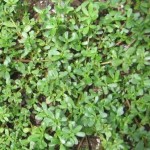Archive for Dandelions
Posted by:
Kate
| Comments
It’s that lovely season when the early Spring greens are up in abundance and are at their peak of nutritiousness. It is also the time when I start my wild edible walks and talks as the Urban Forager! This coming Saturday, April 12th, I will be opening the season with a foraging event at Denver Sustainability Park. We will focus on the Spring greens that our Grandmother’s knew were the best help in clearing the Winter ‘funk’ out of our bodies, gently and surely. These little greens will also nourish you with a super load of vitamins and minerals. So come join me for a two hour experience of learning, foraging, and asking any questions about wild edibles that you have. You can sign up for my walk or contact me for a tour of your own backyard and neighborhood! Remember, if you know your wild local edibles, you’ll never lack for food!
Posted by:
Kate
| Comments
As some of you may know, I am also an Urban Forager and lead wild edible walks in the city neighborhoods. This is the time of year when all sorts of lovely spring greens are available for picking. Gathering the greens for dinner used to be considered part of the walk home from work, and included dandelions, dock, lambs quarters, and various flowers. Depending on the location, other herbs and ‘weeds’ were also available.
As kids we knew about eating the greens we found as we roamed. Slip the thin grass blades of timothy, wild oats, and rye grass from their stems and chew the ends to get some energy. Nibble on ‘sour grass’ or ‘pickle plant’ (Oxalis acetosa) for a lemony taste; use wild mint to add a good flavor to the mouth and aid the stomach. As time passed, we lost touch with the delicious goodness of these wild treats, somehow relegating them to a category of awful pests and weeds to be eliminated. I have a better suggestion: eat these nutritious little goodies after you pull them out of the garden!

One I am particularly fond of is purslane. It looks like a low-growing jade plant, spreading itself over the ground around the plants. I use it as a mulch to retain moisture on my sandy soil, and when there is too much nothing could be simpler to pull than this shallow rooted plant. It contains more omega 3 fatty acids than any other plant I’ve heard of, more than most fish, and can be used so many different ways: raw, sauteed, stewed, stir-fried, pickled, and if you have backyard chickens this is a great way to increase the omega 3 content in their eggs.

Many other cultures use purslane as a vegetable and sell it at the farmers market. I did find it in Ojai, CA at their farmers market! Maybe the local markets will have it soon along with dandelion greens and burdock roots. But why pay for these little goodies? They are there for the taking.
Just be aware and conscious of where you pick them! Make sure the area has not been sprayed with herbicide. You can tell if it has been sprayed if there is a mono-culture (only one type of plant), if the dandelions look stunted, strangely shaped, weirdly wilted, or there are those little flags present. Also, ASK! Don’t pick next to a busy street or thruway. Don’t pick where nothing much is growing, in old parking lots, or in industrial areas.
Also only use the wild edibles for less than half of a salad or cooked dish since they are generally much stronger than the veggies you buy at the store. They won’t hurt you but the idea is to enjoy them, not be overwhelmed by their exotic taste. These plants also will help you detoxify your body, and you want that to be gentle as well. Most of all, have a good time examining these tasty treats, add them to your diet slowly, learn your likes and dislikes, and NEVER eat any plant you do not know!! The library is a valuable resource and has many books on wild edibles. Now there are people like myself in most cities that will teach you about your sources and varieties of free food!
Posted by:
Kate
| Comments
The pale cold skies of January always bring me thoughts of the dense comfort foods of mid-Winter. I started off the New Year with these in my belly, and that feels good! Oatmeal cooked with diced apples and raisins filled the kitchen this morning with delicious smells. It got even better with the addition of chopped pecans (from Ridge Spring, SC – thanks cousin Joe Cal Watson), cinnamon, nutmeg, and a dash of ginger. I eat this with a sterling cereal spoon that belonged to my Great Grandmother Kate Hyde Sloan. There’s a crack in it I was always warned to be careful about, and I have been, for over 60 years. This oatmeal was so good, I ate small bites for a long time!
Lunch was as good – if not better! A bowl of rice and spicy baked butter beans (or lima beans) is still warm in my belly. These are not summer foods for me. They are too dense and heavy for the deep heat and light clothes of summer. And that reminds me of a question a friend from California asked me: “What is seasonal eating ?”
She was referring specifically to being able to buy strawberries in November where she lives. What an interesting question! I’ve spent time thinking about this, because it is different for different parts of our broad, wide country. And yet, there are similarities as well.
In the broadest terms, eating seasonally means eating what is ripe and ready, at that moment, in your locale. It means seeing foods in their freshest state come and go from your menu. It means paying attention to the local farmers world around you day by day. And it means listening to your body and it’s demands. California will be different than New York, Minnesota will be different than Texas.
Here in an area where there are four very distinct seasons it is much more obvious: yummy cold hardy leafy greens in the Spring are an ecstatic addition to any meal at the end of Winter! However it is more than that. During the growing season we eat all of the fresh foods we can, sometimes gorging ourselves with the bounty. The surplus gets dried, frozen, pickled, cured, preserved, canned, smoked, fermented, hung in the pantry or put in a root cellar for the Winter. As one of my Canadian friends said in his Year End letter: “Our search for food these days is fairly simple. What we have is stored in our pantry although there is a stray turnip or two under the foot of snow that finally arrived.” [Thank you, Graham!]
Our bodies have spent millennium adapting and adjusting to what is available, when, and what is not. We have long histories of ‘putting foods by’ so that we have enough to eat all of the time. The temperature and the light tell the cells in our bodies that there is a change in the seasons and we get ready for it. Growing up in a cold winter climate in an uninsulated farm house established a pattern in my body that the first true cold snap brings on. When there is skim ice on the water, my taste for winter foods kicks in – casseroles, baking, hearty soups, and steaming cups of spiced cider. I gain ten pounds each winter (except when I lived in Tucson) and lose it in the Spring once the weather gets warm. I’m used to it. My body obviously needs it. I don’t keep a scale!
My body is primed for seasonal eating, and now that I have added wild foods to my diet, it all makes so much more sense! At the end of winter, there are a few shriveled apples, potatoes, carrots, beets, turnips and parsnips. The garlic and onions are sprouting, and the pantry is becoming full of empty jars. When those first sprouts of green emerge, be they dandelions, wood sorrel, green onions, or lambsquarters, I want them! My body craves them to help purge the heavy winter foods from my body. I don’t want the tomatoes of high summer at that moment, I want new peas, asparagus and strawberries, and the wild baby greens that help me regain my summer figure!
Think of the time and money you save by only going to the store once a week for a few staples. It’s so much simpler once you remember to think about your food ahead of time. Just before bed grab something out of the freezer, put a cup of dried beans in to soak, and even soak the grains for a morning bowl of hot cereal in apple juice or cider! That’s ‘instant’ oatmeal that really counts! If you are not shopping on the way home, you have another 30 minutes to cook an outstanding evening meal.
So think ahead; make menus or find them on line; keep track of the seasons; and have a bright and abundant New Year!


